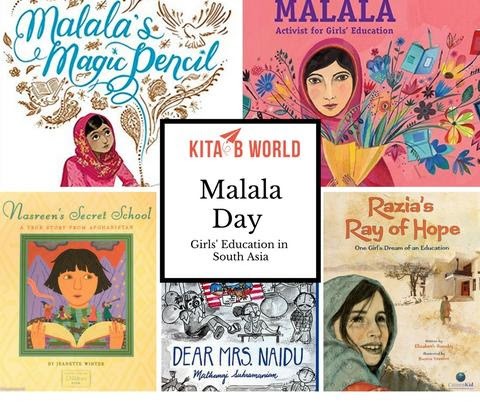We here at Daybreak are seriously fangirling over the awesomeness going on over at Kitaabworld.com. Sadaf Siddique and Gauri Manglik are living the mission of bringing books with South Asian themes, characters, settings and authors to kids all over the world. Here’s how they do it!
- Can you describe Kitaabworld’s mission and a few ways you are pursuing that mission?
At Kitaabworld, we want to make South Asian culture more accessible and mainstream in the US, especially for children. We fulfil our mission in three ways. First, we run an online independent bookstore, through which we facilitate discovery and distribution of South Asian children’s literature, much of which is not otherwise available in the US.
Second, we run an online content platform where we spotlight South Asian authors, publishers and books. We routinely publish curated booklists on various South Asian topics, conduct author interviews and publish guest posts on various topics. Our Counter Islamophobia Through Stories campaign was very successful earlier this year.
Lastly, we collaborate with schools and other institutions to create events with hands-on experiences for kids to learn about South Asian culture. We have done a number of storytimes and other events, some of which are mentioned here.
- Kitaabworld is run by you, Sadaf Siddique, and Gauri Manglik. How did you two meet, and can you let us in on the moment when Kitaabworld was born?
Gauri and I go way back – in fact our husbands go even further back than we do – they were friends in kindergarten! I met Gauri when she got married and moved to the US, but it turned out that we had our own two degrees of separation through common friends. When we were young mothers, we were frustrated by the lack of books in our local library about South Asian culture and identity. Discovering new and relevant books was a struggle. So we took up the challenge and started a worldwide search for South Asian books and put in many hours of research to find books that would appeal to us and our kids. That sparked that idea that we may not be the only South Asian parents searching for such books, so we created an online platform that would facilitate the discovery of, quite frankly, some really interesting books.
- What would you say is the biggest misconception Westerners have about South Asia or South Asians? How are your books addressing this?
I think the biggest misconception most people have is that South Asia is predominantly as a reflection of India and Indian culture. However, South Asia is a very diverse region in geography, food, languages, religions and cultures – all the way from Afghanistan, Pakistan, India and Bangladesh to Bhutan, Nepal, Myanmar, Tibet and Sri Lanka.
We consciously seek to showcase the diversity of South Asia and try and find stories that are rooted in those cultures. My favorite example of this is when we were looking for stories from Afghanistan and came across many stories mostly written from Western imperialist perspectives. So we kept digging till we found a wonderful collection of sufi stories that were traditional oral stories, retold as wonderful picture books and available in local Afghan languages such as Dari and Pashto.
It is still a challenge to locate these stories, but when we do, the thrill is indescribable!
- Can you describe some of the heartwarming and/or disappointing receptions your work has had?
We have had so many wonderful interactions with people who understand the value of multiple stories and the importance of showcasing diversity. Just a few highlights – a school teacher ordered a bunch of books from our Counter Islamophobia Through Stories campaign and told us how excited the Muslim girls in her class were to discover images of someone who dressed and looked like them.
We’ve had so many parents tell us with delight that they can now actually a diverse library in their own homes with characters their kids recognize.
As for disappointing experiences, sometimes people think our books are only meant for South Asians, whereas we are trying to reach mainstream audiences and show them books with wonderful stories, where the color of the character’s skin and their heritage isn’t a barrier to picking up these books.
- Do you travel to seek out books? If so, can you share a story of a book buying adventure you’ve had?
We scouted for books in India, Pakistan and Sri Lanka last summer while we were researching books to set up shop. We chanced upon a small publisher that publishes books on Indian art for children. They are beautifully produced books that now serve as coffee table books in my own home! We would love to travel more, but for now most people find us and reach out to us about their books.
- I know you guys do storytelling and other work with children. What has been the reaction of South Asian kids to your events? Of Western kids? Of teachers?
We love doing story times and getting kids engaged – after all, everyone loves a good story! We’ve seen kids listen with rapt attention, absorbed in the story, responding to the characters and the situations. For a recent art storytime we read A Bhil Story, which was about a drought in a tiny village in central India. The situation rang true with kids in California who were very familiar with conserving water and taking care of our resources, given the ongoing drought from which they only got a reprieve this year.
South Asian kids take a sense of pride in recognizing words and places familiar to them, and love to share traditions and festivals that the others may not be as familiar with. All children are open to learning about new cultures and ask many engaging and thoughtful questions in the discussions that follow.
We really try and advocate for South Asian books and culture and how we experience that culture in our day to day – the music we listen to, the art in our homes, the food we eat, and of course the stories we read, tell and retell.
We’ve done a lot of community outreach, such as an art event based on traditional Pithora art (which is similar to pointillism and Australian aboriginal art), conducted bilingual story times at our local libraries, hosted storytimes on social justice and celebrating diversity. We’ve also created teacher and parent education lectures and panels on cultural appropriation and conducted presentations on Islamophobia.
- Do you and Gauri write books yourself or have aspirations for writing books?
We would love to write our own books, but until then we have found so many great stories and talented authors, we are happy to be surrounded by their work. Not to say we aren’t itching to get our own words on the (printed) page, but all in good time, Insha’Allah! For now, we are inviting young and emerging writers to take part in the KitaabWorld Summer Writing Contest and share their stories.
- You produce wonderful curated book lists on diverse topics relating to South Asia such as holidays and seasons, specific countries and specific topics. How can people sign up to receive these excellent guides for expanding and enriching the diversity of their libraries?
Thank you! We work really hard on trying to create new perspectives for parents, teachers, librarians and other educators. In fact, we recently presented a conversation starter at the ALA Annual Conference in Chicago, and hopefully got the word out to more librarians.
In the meantime, anyone can sign up for our monthly newsletter and follow us on social media – facebook, twitter, instagram and pinterest – for regular updates on new book lists, author interviews and other events and talks.
After all, that’s what we are trying to do – connect you to South Asia, one book at a time.



